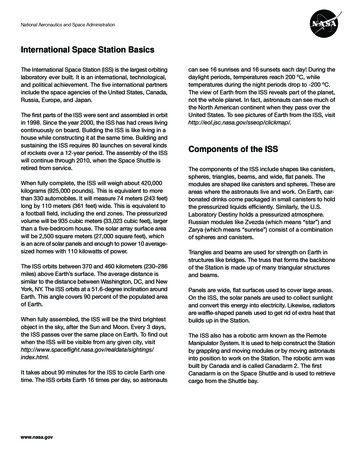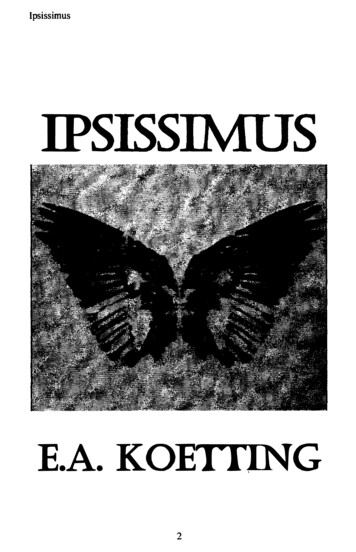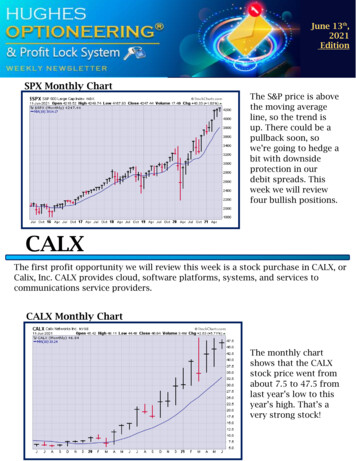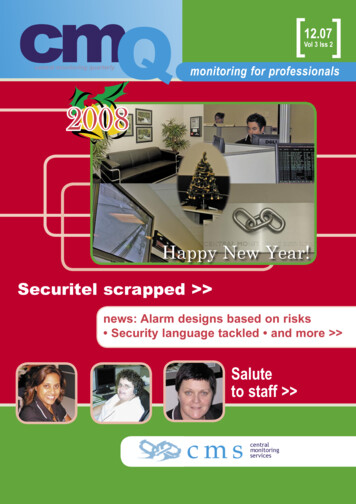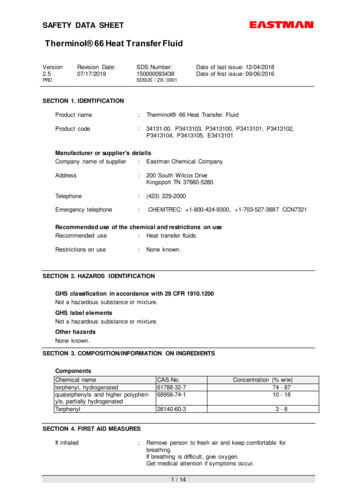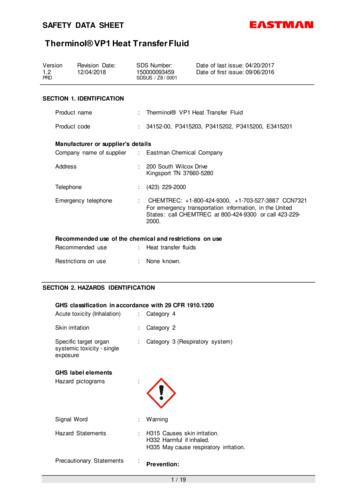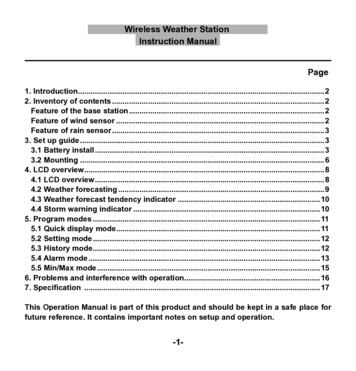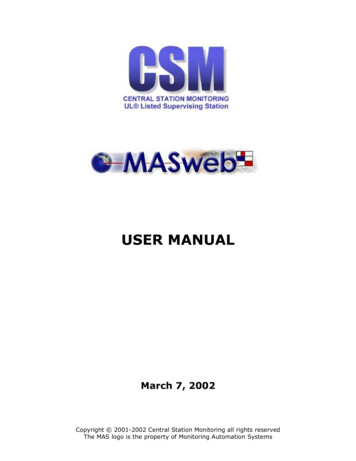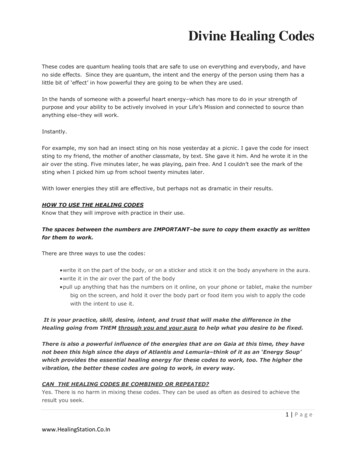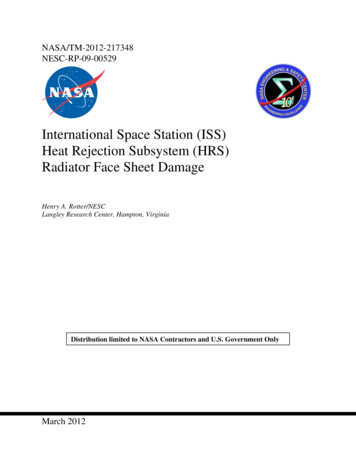
Transcription
NASA/TM-2012-217348NESC-RP-09-00529International Space Station (ISS)Heat Rejection Subsystem (HRS)Radiator Face Sheet DamageHenry A. Rotter/NESCLangley Research Center, Hampton, VirginiaDistribution limited to NASA Contractors and U.S. Government OnlyMarch 2012
NASA STI Program . . . in ProfileSince its founding, NASA has been dedicated tothe advancement of aeronautics and space science.The NASA scientific and technical information (STI)program plays a key part in helping NASA maintainthis important role. CONFERENCE PUBLICATION. Collectedpapers from scientific and technicalconferences, symposia, seminars, or othermeetings sponsored or co-sponsored by NASA. SPECIAL PUBLICATION. Scientific,The NASA STI program operates under thetechnical, or historical information from NASAauspices of the Agency Chief Information Officer. Itprograms, projects, and missions, oftencollects, organizes, provides for archiving, andconcerned with subjects having substantialdisseminates NASA’s STI. The NASA STI programpublic interest.provides access to the NASA Aeronautics and SpaceDatabase and its public interface, the NASA Technical TECHNICAL TRANSLATION. EnglishReport Server, thus providing one of the largestlanguage translations of foreign scientific andcollections of aeronautical and space science STI intechnical material pertinent to NASA’s mission.the world. Results are published in both non-NASAchannels and by NASA in the NASA STI ReportSpecialized services also include creating customSeries, which includes the following report types:thesauri, building customized databases, andorganizing and publishing research results. TECHNICAL PUBLICATION. Reports ofcompleted research or a major significant phaseFor more information about the NASA STIof research that present the results of NASAprogram, see the following:programs and include extensive data ortheoretical analysis. Includes compilations of Access the NASA STI program home page atsignificant scientific and technical data andhttp://www.sti.nasa.govinformation deemed to be of continuingreference value. NASA counterpart of peer E-mail your question via the Internet toreviewed formal professional papers, but havinghelp@sti.nasa.govless stringent limitations on manuscript lengthand extent of graphic presentations. Fax your question to the NASA STI Help Deskat 443-757-5803 TECHNICAL MEMORANDUM. Scientificand technical findings that are preliminary or of Phone the NASA STI Help Desk atspecialized interest, e.g., quick release reports,443-757-5802working papers, and bibliographies that containminimal annotation. Does not contain extensive Write to:analysis.NASA STI Help Desk CONTRACTOR REPORT. Scientific andtechnical findings by NASA-sponsoredcontractors and grantees.NASA Center for AeroSpace Information7115 Standard DriveHanover, MD 21076-1320
NASA/TM-2012-217348NESC-RP-09-00529International Space Station (ISS)Heat Rejection Subsystem (HRS)Radiator Face Sheet DamageHenry A. Rotter/NESCLangley Research Center, Hampton, VirginiaDistribution limited to NASA Contractors and U.S. Government OnlyNational Aeronautics andSpace AdministrationLangley Research CenterHampton, Virginia 23681-2199March 2012
The use of trademarks or names of manufacturers in the report is for accurate reporting and does notconstitute an official endorsement, either expressed or implied, of such products or manufacturers by theNational Aeronautics and Space Administration.Available from:NASA Center for AeroSpace Information7115 Standard DriveHanover, MD 21076-1320443-757-5802
NASA Engineering and Safety CenterTechnical ReportDocument #:Version:NESC-RP09-005291.0Page #:Title:ISS HRS Radiator Face Sheet Damage1 of 83International Space Station (ISS) Heat Rejection Subsystem (HRS)Radiator Face Sheet DamageFebruary 9, 2012Distribution Limited to NASA Contractors and U.S. Government OnlyNESC Request No.: TI-09-00529
NASA Engineering and Safety CenterTechnical ReportDocument #:Version:NESC-RP09-005291.0Page #:Title:ISS HRS Radiator Face Sheet Damage2 of 83Approval and Document Revision HistoryNOTE: This document was approved at the February 9, 2012, NRB. This document wassubmitted to the NESC Director on February 29, 2012, for configuration control.Approved:Original Signature on File3/1/12NESC DirectorVersion1.0Description of RevisionInitial ReleaseDateAuthorMr. Henry Rotter,NASA TechnicalFellow for LifeSupport/ActiveThermal, JohnsonSpace CenterNESC Request No.: TI-09-00529Distribution Limited to NASA Contractors and U.S. Government OnlyEffective Date2/9/12
NASA Engineering and Safety CenterTechnical ReportDocument #:Version:NESC-RP09-005291.0Page #:Title:ISS HRS Radiator Face Sheet Damage3 of 83Table of ContentsTechnical Assessment Report1.0Notification and Authorization . 72.0Signature Page . 83.0Team List . 93.1Acknowledgements . 93.2NESC Involvement . 104.0Executive Summary . 115.0Problem Description . 165.1ISS HRSR Description . 165.1.1 Hydraulic Rupture Analysis . 215.2HRSR Design, Flight and Assembly Data . 215.3Review of MMOD Test Coupons and Data . 245.4IR Thermography . 255.4.1 NDE Imagery Analysis . 28Form Factor Analysis . 335.56.0LS-DYNA Analysis. 366.1Background . 366.1.1 LS-DYNA Overview . 366.1.2 Material Definition. 366.1.3 Model Evolution . 366.2Model 1.0 . 376.2.1 Model 1.0 Results Discussion . 406.3Models 2.0 and 3.0 . 416.3.1 Models 2.0 and 3.0 Results Discussion . 42Model 4.0 . 476.46.4.1 Model 4.0 Results Discussion . 486.4.2 Peer Review . 516.5Model 5.0 . 516.5.1 Model 5.0 Features. 536.5.2 Model 5.0 Results Discussion . 546.6LS-DYNA Analysis Conclusions . 587.0NESC Supported Radiator Testing . 597.1Radiator Tests . 597.1.1 Test 3.1 -- Panel NDE . 607.1.2 Test 3.3 -- Tube Damage/Proof Test. 60NESC Request No.: TI-09-00529Distribution Limited to NASA Contractors and U.S. Government Only
NASA Engineering and Safety CenterTechnical ReportDocument #:Version:NESC-RP09-005291.0Page #:Title:ISS HRS Radiator Face Sheet Damage7.1.37.1.47.27.34 of 83Test 3.8 -- Permeation/Leakage Through Silver-Filled Epoxy From FlowTube . 62Test 3.11 --Panel Segment Pressure Tests . 63General Discussion of Test Results . 70Concluding Remarks . 718.0Findings, Observation, and NESC Recommendations . 718.1Findings. 718.2Observation . 73NESC Recommendations. 738.39.0Alternate Viewpoints . 7310.0Other Deliverables . 7311.0Lessons Learned . 7312.0Definition of Terms . 7313.0Acronyms List . 7414.0References . 7515.0Appendices . 76List of FiguresFigure 4.0-1.Figure 4.0-2.Figure 4.0-3.Figure 4.0-4.Figure 5.1-1.Figure 5.1-2.Figure 5.1-3.Figure 5.1-4.Figure 5.1-5.Figure 5.1-6.Figure 5.1-7.Figure 5.2-1.Figure 5.3-1.Figure 5.3-2.Figure 5.4-1.Figure 5.4-2.HRSR S1-3 Panel 7 Damage . 11Initial Damage Assessment of HRSR S1-3 Panel 7 Survey . 12S1-3 Panel 7 Back Side Face Sheet . 13Panel Test Segment with Face Sheet Peeled Back . 15EATCS Loop A and B Schematic . 16PM including FCV . 17EATCS HRSR Array showing the Dual Flow Paths. 18PVR Deployment. 18HRSR Panel Face Sheets View from Nadir Side . 19Radiator Panel Design Overview . 20Radiator Panel Construction Details . 20S1-3 Array Loop 1 and 2 N2 Pressures . 23Panel 7 MMOD Impact Exit Hole 5/16 Inch (Note ring around hole). 24Impact Test #9; Exit Side and Exit Hole Size ( 0.31-inch-diameter) for a 6.35mm Projectile [ref. 1] . 25Raw Temperature Data Showing Normal Radiator Panel (Center) TemperatureGradients . 26Enhanced IR Imagery of a Thermal-Vacuum Ground Test of a Radiator Panelwith Temperature Range . 26NESC Request No.: TI-09-00529Distribution Limited to NASA Contractors and U.S. Government Only
NASA Engineering and Safety CenterTechnical ReportDocument #:Version:NESC-RP09-005291.0Page #:Title:ISS HRS Radiator Face Sheet DamageFigure 5.4-3.Figure 5.4-4.Figure 5.4-5.Figure 5.4-6.Figure 5.4-7.Figure 5.4-8.Figure 5.4-9.5 of 83Normal Radiator Temperature Contour Plot Showing Flow Paths . 27Possible Frozen Flow Path on S1-2 Panel 7 (Center Array) . 27IR Imagery Processing Results . 28Registration of Images Based on Affine Transform. 30Transformation of ISS HRSR Panel from Camera to Normal Views . 30(a) Temperature Image of HRSR Panel (b) Laplacian Image . 31(a) Laplacian Image of a Damaged Panel (b) Laplacian Image of anUndamaged Panel . 31Figure 5.4-10. Temperature Profiles for Analogous Cooling Tubes Compared for EachRadiator . 32Figure 5.5-1. Thermal Desktop Geometric Model of ISS (with Starboard HRSRNodalization shown) . 34Figure 5.5-2. IR Imagery Depicting Panel-to-Panel Temperature Trends . 35Figure 5.5-3. Form Factor to Space Results for Case 1 . 35Figure 6.2-1. (Top) State of Face Sheet Prior to Failure Initiation, (Bottom) Face SheetFailure Propagation . 38Figure 6.2-2. Face Sheet Lifting. 39Figure 6.2-3. Face Sheet Fold Over . 40Figure 6.2-4. Side View of Figure 6.2-2 Depicting Incorrect Penetration of the Face Sheetinto the Honeycomb Volume . 41Figure 6.3-1. Radiator Features (Models 2.0 and 3.0) . 42Figure 6.3-2. Pressure Ramp Down Study for Models 2.0 and 3.0 . 43Figure 6.3-3. Failure Propagation in Model 2.0, Front and Side Views . 44Figure 6.3-4. Failure Propagation in Model 3.0, Front and Side Views . 45Figure 6.3-5. On-orbit Image of Radiator Panel showing Face Sheet Displacement . 46Figure 6.3-6. Face Sheet Tearing Along the Bolt Holes . 46Figure 6.3-7. Comparison of Wrinkling Features to On-orbit Images . 47Figure 6.4-1. Peel Test Configuration . 48Figure 6.4-2. Model 4.0 at Impact State . 49Figure 6.4-3. Marking on Panel 7 Neighboring Panel . 50Figure 6.4-4. Simple Paper Model shows the Folded Face Sheet Lines up with the Markingon the Neighboring Panel. 50Figure 6.5-1. Calculated Pressure Unloading Time History . 52Figure 6.5-2. A Comparison of Bolted Constraint Definitions . 53Figure 6.5-3. Zoomed View of the Failure Progression as the Face Sheet Pulls from theBolts . 55Figure 6.5-4. Comparison of Bolt Pullout Near Failure Initiation and Tearing Along BoltHoles . 56Figure 6.5-5. Comparison of the Location of the Contact Edge in the LS-DYNA Model tothe Paper Model . 57Figure 7.1-1. Subset of Overall Test Plan Presented to MVCB and SSPCB . 59NESC Request No.: TI-09-00529Distribution Limited to NASA Contractors and U.S. Government Only
NASA Engineering and Safety CenterTechnical ReportDocument #:Version:NESC-RP09-005291.0Page #:Title:ISS HRS Radiator Face Sheet DamageFigure 7.1-2.Figure 7.1-3.Figure 7.1-4.Figure 7.1-5.Figure 7.1-6.Figure 7.1-7.Figure 7.1-8.Figure 7.1-9.Figure 7.1-10.Figure 7.1-11.Figure 7.1-12.Figure 7.1-13.Figure 7.1-14.6 of 83Parent Material Defect Detected During Inspection . 61Silver-Filled Epoxy Testing with Ammonia . 62Panel Test Segment 6-7 . 64Panel Test Segment 8-8 . 64Panel Test Segment 6-3 . 65Panel Test Segment 6-2 . 65Panel Segment 6-7, Post Leak Test Condition . 66Delaminated Face Sheet . 67Delaminated Face Sheet . 67X-Ray View Depicting Lagoons . 68HOBE Lagoons Revealed After Removal of Face Sheet . 69HOBE Bond Failures from the Face Sheet . 69Comparison Between Test Failure and Panel 7 Images Showing RipplesPerpendicular to the Flow Tube Orientation . 70List of TablesTable 5.5-1.Table 6.5-1.Table 7.1-1.Form Factor Analysis Case Summary with Joint Rotation Angles (Degrees) . 33Feature Comparison Between Model Predictions and On-orbit Images . 58Comparison of Test Article Environments to HRSR Environment [ref. 14] . 60NESC Request No.: TI-09-00529Distribution Limited to NASA Contractors and U.S. Government Only
NASA Engineering and Safety CenterTechnical ReportDocument #:Version:NESC-RP09-005291
Fax your question to the NASA STI Help Desk at 443-757-5803 Phone the NASA STI Help Desk at 443-757-5802 Write to: NASA STI Help Desk NASA Center for AeroSpace Information 7115 Standard Drive Hanover, MD 21076-1
